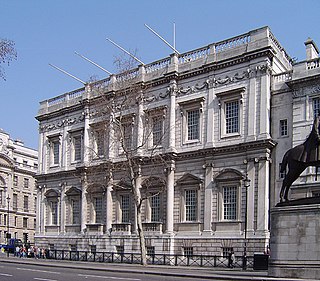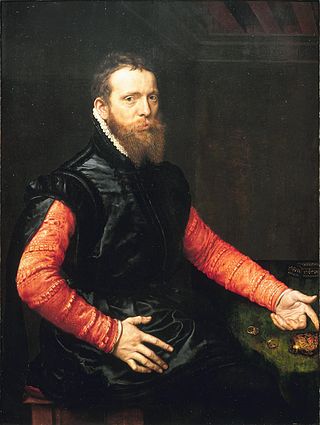Related Research Articles

Isaac Oliver or Olivier was an English portrait miniature painter.

Lionel Cranfield, 1st Earl of Middlesex was an English merchant and politician. He sat in the House of Commons between 1614 and 1622 when he was raised to the peerage as Baron Cranfield.

The Banqueting House, on Whitehall in the City of Westminster, central London, is the grandest and best-known survivor of the architectural genre of banqueting houses, constructed for elaborate entertaining. It is the only large surviving component of the Palace of Whitehall, the residence of English monarchs from 1530 to 1698. The building is important in the history of English architecture as the first structure to be completed in the classical style of Palladian architecture which was to transform English architecture.

John de Critz or John Decritz was one of a number of painters of Flemish origin active at the English royal court during the reigns of James I of England and Charles I of England. He held the post of Serjeant Painter to the king from 1603, at first jointly with Leonard Fryer and from 1610 jointly with Robert Peake the Elder.

The Serjeant Painter was an honourable and lucrative position as court painter with the English monarch. It carried with it the prerogative of painting and gilding all of the King's residences, coaches, banners, etc. and it grossed over £1,000 in a good year by the 18th century. The work itself involved painting the palaces, coaches, royal barges, and all sorts of decorations for festivities, which often had to be designed as well. The actual involvement of the serjeant painters in this gradually declined. The post itself fell out of use in the 18th century, after a period when "fine art" painters were appointed, and expected to supervise rather than execute decorative painting, for a good salary.

Rowland Lockey was an English painter and goldsmith, and was the son of Leonard Lockey, a crossbow maker of the parish of St Bride's, Fleet Street, London. Lockey was apprenticed to Queen Elizabeth's miniaturist and goldsmith Nicholas Hilliard for eight years beginning Michaelmas 1581 and was made a freeman or master of the Worshipful Company of Goldsmiths by 1600.

The artists of the Tudor court are the painters and limners engaged by the monarchs of England's Tudor dynasty and their courtiers between 1485 and 1603, from the reign of Henry VII to the death of Elizabeth I.

Robert Peake the Elder was an English painter active in the later part of Elizabeth I's reign and for most of the reign of James I. In 1604, he was appointed picture maker to the heir to the throne, Prince Henry; and in 1607, serjeant-painter to King James I – a post he shared with John De Critz.

Steven van der Meulen was a Flemish artist active c. 1543–1563. He gained prominence in England in the first decade of the reign of Elizabeth I as one of many Flemish artists active at the Tudor court.

Steven Cornelisz. van Herwijck, was a Netherlandish sculptor and gem engraver famous for his portrait medallions and medals. He spent two periods of his career in England, where he died. It has recently been suggested that he is the "famous paynter Steven" mentioned in an inventory of 1590, who has traditionally been identified as Steven van der Meulen.

Adrian Vanson was a portrait artist who worked for James VI of Scotland.

Cornelis de Neve or Cornelius de Neve, was a Flemish painter who worked for a long period in England as a portrait artist.

Cornelius de Vos or de Vois or Devosse, was a Dutch or Flemish mine entrepreneur and mineral prospector working in England and Scotland. He was said to have been a "picture-maker" or portrait artist. De Vos is known for gold mining in Scotland and founding saltworks at Newhaven near Edinburgh.
Rachael Emily Poole was an historian of portraiture, with a particular focus on miniatures, active in the United Kingdom. She played a key part in cataloguing local and university artwork and architecture in Oxford.
John Workman or Warkman was a decorative painter working in Edinburgh.
Thomas Capp or Cappe was a London-based painter and gilder.
Niccolo da Modena or Nicholas Bellin of Modena was an Italian artist and technician at the English court.

Oliver de Critz was an English painter.
Oliver Browne was a London upholsterer and furniture maker in the 17th century who worked for aristocrats and the royal court. His business partners included John Baker, another upholsterer or "upholder", who worked for the royal family. Baker was "upholster" to James VI and I and Prince Henry, and had supplied items for the coronation of James I and Anne. Baker's son, also John Baker, continued the business after the Restoration.
Ralph Grynder or Grinder was a London-based furniture maker and upholsterer who worked for Charles I of England and Henrietta Maria. He bought and sold art treasures from the Royal Collection in 1651.
References
- ↑ Edward Town, 'A Biographical Dictionary of London Painters, 1547-1625', Walpole Society Volume, 76 (2014), pp. 82-4.
- ↑ Edward Town, 'A Biographical Dictionary of London Painters, 1547-1625', Walpole Society Volume, 76 (2014), p. 82.
- ↑ Howard Colvin, History of the King's Works, 3:1 (London: HMSO, 1975), p. 411.
- ↑ Christina Young, 'The Changing Role and Status of Scenic Artists in England', Nicola Costaras & Christina Young, Setting the Scene (London, 2013), p. 100
- ↑ Edward Town, 'A Biographical Dictionary of London Painters, 1547-1625', Walpole Society Volume, 76 (2014), p. 83.
- ↑ Ian C. Bristow, Architectural Colour in British Interiors, 1615-1840 (Yale, 1996), pp. 2, 11.
- ↑ Howard Colvin, The History of the King's Works, 4:2 (London: HMSO, 1982), pp. 33, 37, 111–100.
- ↑ Ian W. Archer, 'City and Court Connected: The Material Dimensions of Royal Ceremonial, ca. 1480–1625', Huntington Library Quarterly, 71:1 (March 2008), p. 163.
- ↑ Edward Town, 'A Biographical Dictionary of London Painters, 1547-1625', Walpole Society Volume, 76 (2014), p. 83.
- ↑ Edward Town, 'A Biographical Dictionary of London Painters, 1547-1625', Walpole Society Volume, 76 (2014), p. 83: Ian W. Archer, 'City and Court Connected: The Material Dimensions of Royal Ceremonial, ca. 1480–1625', Huntington Library Quarterly, 71:1 (March 2008), p. 175.
- ↑ Edward Town, 'A Biographical Dictionary of London Painters, 1547-1625', Walpole Society Volume, 76 (2014), p. 84.
- ↑ Edward Town, 'A Biographical Dictionary of London Painters, 1547-1625', Walpole Society Volume, 76 (2014), p. 84.
![]() This article incorporates text from a publication now in the public domain : "Fryer, Leonard". Dictionary of National Biography . London: Smith, Elder & Co. 1885–1900.
This article incorporates text from a publication now in the public domain : "Fryer, Leonard". Dictionary of National Biography . London: Smith, Elder & Co. 1885–1900.